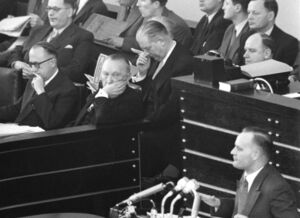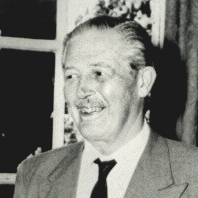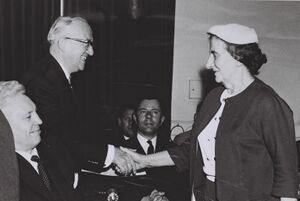Difference between revisions of "Walter Hallstein"
(cut more) |
m (Text replacement - "e served in" to "e was in") |
||
| (3 intermediate revisions by one other user not shown) | |||
| Line 29: | Line 29: | ||
|next=2 July 1967 | |next=2 July 1967 | ||
}}{{job | }}{{job | ||
| − | |title=State Secretary at the Federal Foreign Office | + | |title=State Secretary at the German Federal Foreign Office |
|start=2 April 1951 | |start=2 April 1951 | ||
|end=7 January 1958 | |end=7 January 1958 | ||
| Line 48: | Line 48: | ||
==Project Sunflower reeducation== | ==Project Sunflower reeducation== | ||
| − | In 1942 Hallstein was called up; he | + | In 1942 Hallstein was called up; he was in an [[artillery]] regiment of the [[Wehrmacht]] in Northern France with the rank of [[first lieutenant]]. In early 1944, Hallstein's name was submitted by the [[Frankfurt University|University of Frankfurt]] as a potential ''Nationalsozialistischer Führungsoffizier'' to the [[National Socialist German Lecturers League|National Socialist Lecturers League]].<ref>Heiber, Helmut (1991). ''Universität unterm Hakenkreuz Teil 1. Der Professor im Dritten Reich : Bilder aus der akademischen Provinz'' [University under the Swastika, Part 1. Professor under the Third Reich : Pictures of the academic province] (in German). K. G. Saur. p. 360. ISBN 3-598-22629-2.</ref> |
After the Allied landings in Normandy, he was taken prisoner by the Americans in June [[1944]] and was brought to the [[United States]]. At Camp Como camp in [[Mississippi]], he helped set up a camp university and resumed his academic studies. He belonged to a select group of people who received special training from the American authorities as part of the "[[Project Sunflower]]", a reeducation as possible future decision-makers. He also taught at this camp university. As part of the project, he attended an "administrative school" at [[Fort Getty]], where teaching included the principles of the [[Constitution of the United States]]. Hallstein remained a prisoner of war from June 1944 to mid-1945.<ref>Freiberger, Thomas (2010). "Der friedliche Revolutionär: Walter Hallsteins Epochenbewusstsein" page 225 </ref> | After the Allied landings in Normandy, he was taken prisoner by the Americans in June [[1944]] and was brought to the [[United States]]. At Camp Como camp in [[Mississippi]], he helped set up a camp university and resumed his academic studies. He belonged to a select group of people who received special training from the American authorities as part of the "[[Project Sunflower]]", a reeducation as possible future decision-makers. He also taught at this camp university. As part of the project, he attended an "administrative school" at [[Fort Getty]], where teaching included the principles of the [[Constitution of the United States]]. Hallstein remained a prisoner of war from June 1944 to mid-1945.<ref>Freiberger, Thomas (2010). "Der friedliche Revolutionär: Walter Hallsteins Epochenbewusstsein" page 225 </ref> | ||
| Line 97: | Line 97: | ||
This independence from the United States was one of de Gaulle's main objectives; he was against the increased integration of Europe under the umbrella of [[transatlantic]] integration as provided for in the Rome treaties.{{sfn | Loth|1998| p=139}} | This independence from the United States was one of de Gaulle's main objectives; he was against the increased integration of Europe under the umbrella of [[transatlantic]] integration as provided for in the Rome treaties.{{sfn | Loth|1998| p=139}} | ||
| − | |||
The [[Hallstein Commission]] drew up plans and a timetable for an [[Economic union|economic]] and [[currency union]], and Hallstein presented these to the [[Council of Ministers (European Union)|Council of Ministers]] and the [[European Parliament]] in October 1962.{{sfn | Groeben|1998 | p=98}} | The [[Hallstein Commission]] drew up plans and a timetable for an [[Economic union|economic]] and [[currency union]], and Hallstein presented these to the [[Council of Ministers (European Union)|Council of Ministers]] and the [[European Parliament]] in October 1962.{{sfn | Groeben|1998 | p=98}} | ||
| − | |||
A second attempt by de Gaulle to establish a closer political union in Europe that would be independent of the United States was the [[Élysée Treaty|Franco-German bilateral treaty on political cooperation]]. This treaty between France and Germany, which was signed on 22 January 1963, was criticized by other countries as being incompatible with the EEC and [[NATO]] treaties. Hallstein and other members of the Commission also criticized the treaty, and this angered de Gaulle.{{sfn | Groeben|1998 | pp = 97–101}} | A second attempt by de Gaulle to establish a closer political union in Europe that would be independent of the United States was the [[Élysée Treaty|Franco-German bilateral treaty on political cooperation]]. This treaty between France and Germany, which was signed on 22 January 1963, was criticized by other countries as being incompatible with the EEC and [[NATO]] treaties. Hallstein and other members of the Commission also criticized the treaty, and this angered de Gaulle.{{sfn | Groeben|1998 | pp = 97–101}} | ||
When the treaty was ratified by West Germany, the [[German Bundestag]] unilaterally added a [[preamble]] that re-affirmed the commitment to close transatlantic ties, the enlargement of the existing European Communities and attempts to secure Britain's accession. Since Britain had firmly expressed its unwillingness to support an autonomous European defence independent of America, de Gaulle regarded the treaty as a failure.{{sfn | Loth|1998| p=139}} | When the treaty was ratified by West Germany, the [[German Bundestag]] unilaterally added a [[preamble]] that re-affirmed the commitment to close transatlantic ties, the enlargement of the existing European Communities and attempts to secure Britain's accession. Since Britain had firmly expressed its unwillingness to support an autonomous European defence independent of America, de Gaulle regarded the treaty as a failure.{{sfn | Loth|1998| p=139}} | ||
| Line 111: | Line 109: | ||
In his memoirs, De Gaulle wrote of Hallstein: | In his memoirs, De Gaulle wrote of Hallstein: | ||
{{SMWQ | {{SMWQ | ||
| − | |subjects=European Union | + | |subjects=European Union,European Commission |
|text=He was ardently wedded to the thesis of the super-State, and bent all his skilful efforts towards giving the Community the character and appearance of one. He had made [[Brussels]], where he resided, into a sort of capital. There he sat, surrounded with all the trappings of sovereignty, directing his colleagues, allocating jobs among them, controlling several thousand officials who were appointed, promoted and remunerated at his discretion, receiving the credentials of foreign ambassadors, laying claim to high honors on the occasion of his official visits, concerned above all to further the amalgamation of the Six, believing that the pressure of events would bring about what he envisaged. | |text=He was ardently wedded to the thesis of the super-State, and bent all his skilful efforts towards giving the Community the character and appearance of one. He had made [[Brussels]], where he resided, into a sort of capital. There he sat, surrounded with all the trappings of sovereignty, directing his colleagues, allocating jobs among them, controlling several thousand officials who were appointed, promoted and remunerated at his discretion, receiving the credentials of foreign ambassadors, laying claim to high honors on the occasion of his official visits, concerned above all to further the amalgamation of the Six, believing that the pressure of events would bring about what he envisaged. | ||
|authors=Charles de Gaulle | |authors=Charles de Gaulle | ||
Latest revision as of 03:10, 12 September 2024
(academic, lawyer, diplomat, deep state operative) | |||||||||||||||||||||||
|---|---|---|---|---|---|---|---|---|---|---|---|---|---|---|---|---|---|---|---|---|---|---|---|
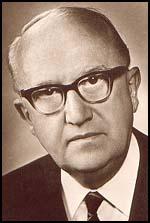 | |||||||||||||||||||||||
| Born | Walther Peter Hallstein 17 November 1901 Mainz, Germany | ||||||||||||||||||||||
| Died | 29 March 1982 (Age 80) Stuttgart, Germany | ||||||||||||||||||||||
| Nationality | German | ||||||||||||||||||||||
| Alma mater | Friedrich Wilhelm University, University of Bonn, University of Munich | ||||||||||||||||||||||
| Party | Christian Democratic Union | ||||||||||||||||||||||
Taken prisoner by the Americans in June 1944, where he was selected for special training as part of "Project Sunflower", a reeducation plan for possible future decision-makers. Became one of the founding fathers of the European Union. Multi-Bilderberg
| |||||||||||||||||||||||
Walter Hallstein was a German politician. Having been hand-picked by the allied government after World War 2, he as State Secretary led the diplomatic isolation of East Germany. In 1958, he became the first president of the European Commission, a post he held for ten years.
Contents
Background
Walter Hallstein was born on November 17, 1901 in Mainz. After graduating from high school, Hallstein studied law in Bonn, Munich and Berlin. After passing the first state examination, he completed a dissertation in 1925 on the "Life Insurance Contract in the Versailles Treaty". [1]
Career
Hallstein received a teaching position at the Friedrich-Wilhelms-Universität in Berlin and embarked on an academic career, with his doctoral supervisor Martin Wolff and the Austrian Ernst Rabel, newly appointed to Berlin, becoming his sponsors. In 1927, Rabel took Hallstein with him to the renowned Kaiser Wilhelm Institute for Foreign and International Private Law.
Hallstein's excellent academic reputation was demonstrated by the fact that he was appointed to a professorship for economic and commercial law at the University of Rostock on October 1, 1930 - at just 28 years of age he was one of the youngest professors in Germany.
From 1936 until he moved to the University of Frankfurt am Main in 1941, Hallstein also held the position of dean of the Faculty of Law and Economics.
Project Sunflower reeducation
In 1942 Hallstein was called up; he was in an artillery regiment of the Wehrmacht in Northern France with the rank of first lieutenant. In early 1944, Hallstein's name was submitted by the University of Frankfurt as a potential Nationalsozialistischer Führungsoffizier to the National Socialist Lecturers League.[2]
After the Allied landings in Normandy, he was taken prisoner by the Americans in June 1944 and was brought to the United States. At Camp Como camp in Mississippi, he helped set up a camp university and resumed his academic studies. He belonged to a select group of people who received special training from the American authorities as part of the "Project Sunflower", a reeducation as possible future decision-makers. He also taught at this camp university. As part of the project, he attended an "administrative school" at Fort Getty, where teaching included the principles of the Constitution of the United States. Hallstein remained a prisoner of war from June 1944 to mid-1945.[3]
Hallstein came back to Germany in November 1945. In the heavily destroyed financial center, he helped to enable the reopening of the University of Frankfurt. What he was aiming for in 1945 he was able to achieve three years later: he took on a visiting professorship at Georgetown University in Washington DC for a year. During this time he was able to make important contacts with American scientists and politicians and became part of the early Cold War tie between Americans and West Germans establishing transatlantic networks.
State Secretary at the Foreign Office (1951–1958)
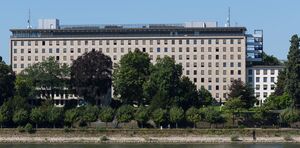
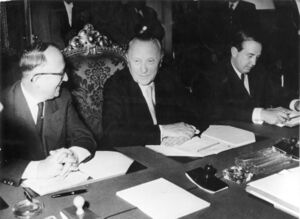
Following a change in the Occupation Statute, the German Foreign Office was re-created in March 1951, but the post of Foreign Minister was filled by Adenauer himself. On 2 April 1951, Hallstein was made the leading civil servant at the newly created Foreign Office.
Foreign policy continued to be managed by Adenauer himself with his group of intimates, including Hallstein, Blankenhorn and others. In many respects Hallstein was the West German Foreign Minister in all but name.
Hallstein played an important part in promoting West Germany's goals of regaining sovereignty and creating a European Defence Community (EDC), of which West Germany would be a member.[4] Negotiations at first resulted in two international agreements:
- On 26 May 1952, the Treaty of Bonn was signed by the United States, United Kingdom, France, and West Germany; on ratification, it would largely restore sovereignty to the Federal Republic of Germany (de facto West Germany, but not including West Berlin, which retained a special status).
- On 27 May 1952, the Treaty of Paris was signed by the United States, France, Italy, Belgium, Netherlands, Luxembourg, and West Germany; on ratification, it would have established the European Defence Community (EDC).
However, the Treaty of Paris failed to obtain the necessary approval of the French Parliament. Instead, a solution involving the Western European Union (WEU) was agreed, and West Germany was to become a member of NATO. After the ratification of the Paris Accords on 5 May 1955, the General Treaty (Deutschlandvertrag), which largely restored (West) German sovereignty, took full effect; the Federal Republic of Germany became a member of NATO.
On 6 June 1955, Adenauer, who had until then been Foreign Minister as well as Chancellor, appointed Heinrich von Brentano foreign minister and there was a reshuffling of responsibilities, but Hallstein retained the trust of Adenauer and continued to attend cabinet meetings.[5] Herbert Blankenhorn, who until then been the head of the Political Department of the Foreign Office, became the German Permanent Representative to NATO in Paris; Wilhelm Grewe took over the Political Department under Hallstein and was made Hallstein's deputy.
Hallstein Doctrine
Hallstein is also the person behind the Hallstein Doctrine, which the state of West Germany proclaimed in 1955. It meant that West Germany wouldn't have diplomatic relations with countries that recognized East Germany. The idea behind the Hallstein Doctrine came from Hallstein's deputy, Wilhelm Grewe. The doctrine would become one of the major elements of West German foreign policy from September 1955;– until official recognition of the German Democratic Republic in October 1969.
Based on the Basic Law, its de facto constitution, the Federal Republic of Germany, it claimed an exclusive mandate to represent the whole of Germany, including the Communist East Germany, which was aligned with the Soviet Union. One of the early objectives of West German foreign policy was the diplomatic isolation of East Germany. No official text of the so-called "doctrine" was made public, but it was explained publicly in a radio interview[6] by its main architect, Wilhelm Grewe. Adenauer also explained the outlines of the policy in a statement to the German parliament on 22 September 1955.
European integration and President of the European Commission
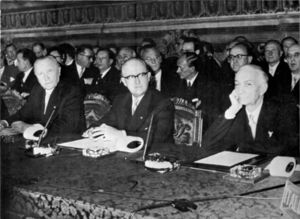
On 25 March 1957, the six countries Belgium, France, Germany, Italy, Luxemburg, and Netherlands signed the Treaties of Rome. Adenauer and Hallstein signed for Germany.[7] The foreign minister, Brentano had largely left the negotiations to Hallstein, so the signing of the treaty represented a major success for Hallstein.[8]
On 7 January 1958, at a conference of Foreign Ministers in Paris, Hallstein was elected president of the first commission of the newly created EEC. In the same year, he was sharply criticized, especially by the British and Scandinavian sides, because he was one of the most determined opponents of the ultimately failed plans for a European free trade area with many members and, on the contrary, relied on an economically and politically strongly integrated, but small group of European states. At the end of 1959, he published the Hallstein Plan, which provided for a stronger common market of the EEC countries with simultaneous liberalization of foreign trade. In the following years, negotiations on this project took place, which was implemented at the beginning of 1962 after tough discussions, especially on agricultural policy.
Hallstein famously described his role as "a kind of European prime minister" and regarded national sovereignty as a "doctrine of yesteryear."[9] Though Hallstein's personal vision of a federal Europe was clear, the EEC treaty left many questions open. Opinions were divided, for instance, on whether a common market could succeed without a common economic policy, on enlargement of the European Union – in particular whether Britain should join – and whether the final goal should be a political union in the sense of a "United States of Europe".[10]
Confrontation with de Gaulle
Differing interests and traditions in the member states and differences of opinion among the politicians meant that consensus was difficult. The disagreements that had preceded the creation of the EEC continued after it was established, and these were reflected within the Commission.
It was in 1961 that de Gaulle proposed the Fouchet Plan, a plan for an intergovernmental "union of states", as an alternative to the European Communities. There was little support from the other European countries, and negotiations were abandoned on 17 April 1962.[11]
While Hallstein had a decidedly federal vision for Europe, and regarded the Commission as a quasi-federal organ,[12] de Gaulle's vision was of a confederation.[13] From the beginning, Hallstein did not believe that de Gaulle's approach of cooperation between sovereign nation states would be able to realize his vision of a powerful Europe that could play its proper part on the world stage.[12]
De Gaulle also envisaged a pooling of sovereignty in certain areas, such as external defence, harmonization of industrial production and foreign trade, currency, exploitation of resources in overseas territories, and cultural and scientific development,[14] but at the same time he was developing the French nuclear deterrent capability, the Force de Frappe, which he envisaged as part of a European defence capability independent of the United States.[13] This independence from the United States was one of de Gaulle's main objectives; he was against the increased integration of Europe under the umbrella of transatlantic integration as provided for in the Rome treaties.[11]
The Hallstein Commission drew up plans and a timetable for an economic and currency union, and Hallstein presented these to the Council of Ministers and the European Parliament in October 1962.[15]
A second attempt by de Gaulle to establish a closer political union in Europe that would be independent of the United States was the Franco-German bilateral treaty on political cooperation. This treaty between France and Germany, which was signed on 22 January 1963, was criticized by other countries as being incompatible with the EEC and NATO treaties. Hallstein and other members of the Commission also criticized the treaty, and this angered de Gaulle.[10] When the treaty was ratified by West Germany, the German Bundestag unilaterally added a preamble that re-affirmed the commitment to close transatlantic ties, the enlargement of the existing European Communities and attempts to secure Britain's accession. Since Britain had firmly expressed its unwillingness to support an autonomous European defence independent of America, de Gaulle regarded the treaty as a failure.[11]
Further attempts by de Gaulle at military cooperation with Germany to the exclusion of America were rebuffed by Erhard (now Federal Chancellor) and his foreign minister Gerhard Schröder.[11] Britain's application for membership of the EEC was vetoed by de Gaulle in 1963, which also further antagonized the other participants.[11]
De Gaulle complained of the Commission usurping a political role reserved for governments and of Hallstein usurping a role reserved for heads of government or heads of state; he attacked Hallstein personally saying that Hallstein was trying to turn the EEC into a superstate, with Brussels as its capital; he talked of defending French democracy against an unaccountable and stateless technocracy, "a technocratic Areopagus, stateless and unaccountable" [De Gaulle at a press conference at the Elysée Palace on 9 September 1965].
In his memoirs, De Gaulle wrote of Hallstein:
“He was ardently wedded to the thesis of the super-State, and bent all his skilful efforts towards giving the Community the character and appearance of one. He had made Brussels, where he resided, into a sort of capital. There he sat, surrounded with all the trappings of sovereignty, directing his colleagues, allocating jobs among them, controlling several thousand officials who were appointed, promoted and remunerated at his discretion, receiving the credentials of foreign ambassadors, laying claim to high honors on the occasion of his official visits, concerned above all to further the amalgamation of the Six, believing that the pressure of events would bring about what he envisaged.”
Charles de Gaulle (1971) [16]
Later life (1967–1982)
In 1967, under pressure from France, Hallstein announced that he would not run for a new term. He then became chairman of the International European Movement (EMI) from 1968 to 1974. From 20 October 1969 to 22 September 1972, Hallstein represented the Neuwied constituency in the German Bundestag as a directly elected CDU member of Parliament. He interpreted Chancellor Willy Brandt's new Ostpolitik as a resurgence of isolationist nation-state aspirations.
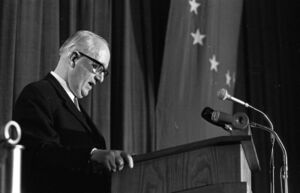
Hallstein remained a bachelor all his life.[17]
Events Participated in
| Event | Start | End | Location(s) | Description |
|---|---|---|---|---|
| 1948 Hague Congress | 7 May 1948 | 11 May 1948 | Netherlands The Hague | Landmark conference which had a profound influence on the shape of the European Movement. Many of the groups organizing the conference received covert funding from the CIA. |
| Bilderberg/1955 September | 23 September 1955 | 25 September 1955 | Germany Bavaria Garmisch-Partenkirchen | The third Bilderberg, in West Germany. The subject of a report by Der Spiegel which inspired a heavy blackout of subsequent meetings. |
| Bilderberg/1956 | 11 May 1956 | 13 May 1956 | Denmark Fredensborg | The 4th Bilderberg meeting, with 147 guests, in contrast to the generally smaller meetings of the 1950s. Has two Bilderberg meetings in the years before and after |
| Bilderberg/1958 | 13 September 1958 | 15 September 1958 | United Kingdom Buxton UK | The 7th Bilderberg and the first one in the UK. 72 guests |
References
- ↑ https://www.konrad-adenauer.de/personen/h/hallstein-walter
- ↑ Heiber, Helmut (1991). Universität unterm Hakenkreuz Teil 1. Der Professor im Dritten Reich : Bilder aus der akademischen Provinz [University under the Swastika, Part 1. Professor under the Third Reich : Pictures of the academic province] (in German). K. G. Saur. p. 360. ISBN 3-598-22629-2.
- ↑ Freiberger, Thomas (2010). "Der friedliche Revolutionär: Walter Hallsteins Epochenbewusstsein" page 225
- ↑ Elvert 2011.
- ↑ Lahn 1998, p. 25.
- ↑ http://www.1000dokumente.de/index.html?c=dokument_de&dokument=0019_hal
- ↑ Piela 2010, p. 3.
- ↑ Küsters 1998, p. 74.
- ↑ Soetendorp 2014, p. 20.
- ↑ a b Groeben 1998, pp. 97–101.
- ↑ a b c d e Loth 1998, p. 139.
- ↑ a b Groeben 1998, pp. 96–97.
- ↑ a b Loth 1998, pp. 137–138.
- ↑ Loth 1998, p. 137.
- ↑ Groeben 1998, p. 98.
- ↑ Mémoires d'Espoir, page 184
- ↑ Kilian M 2005, p. 374.
Wikipedia is not affiliated with Wikispooks. Original page source here
